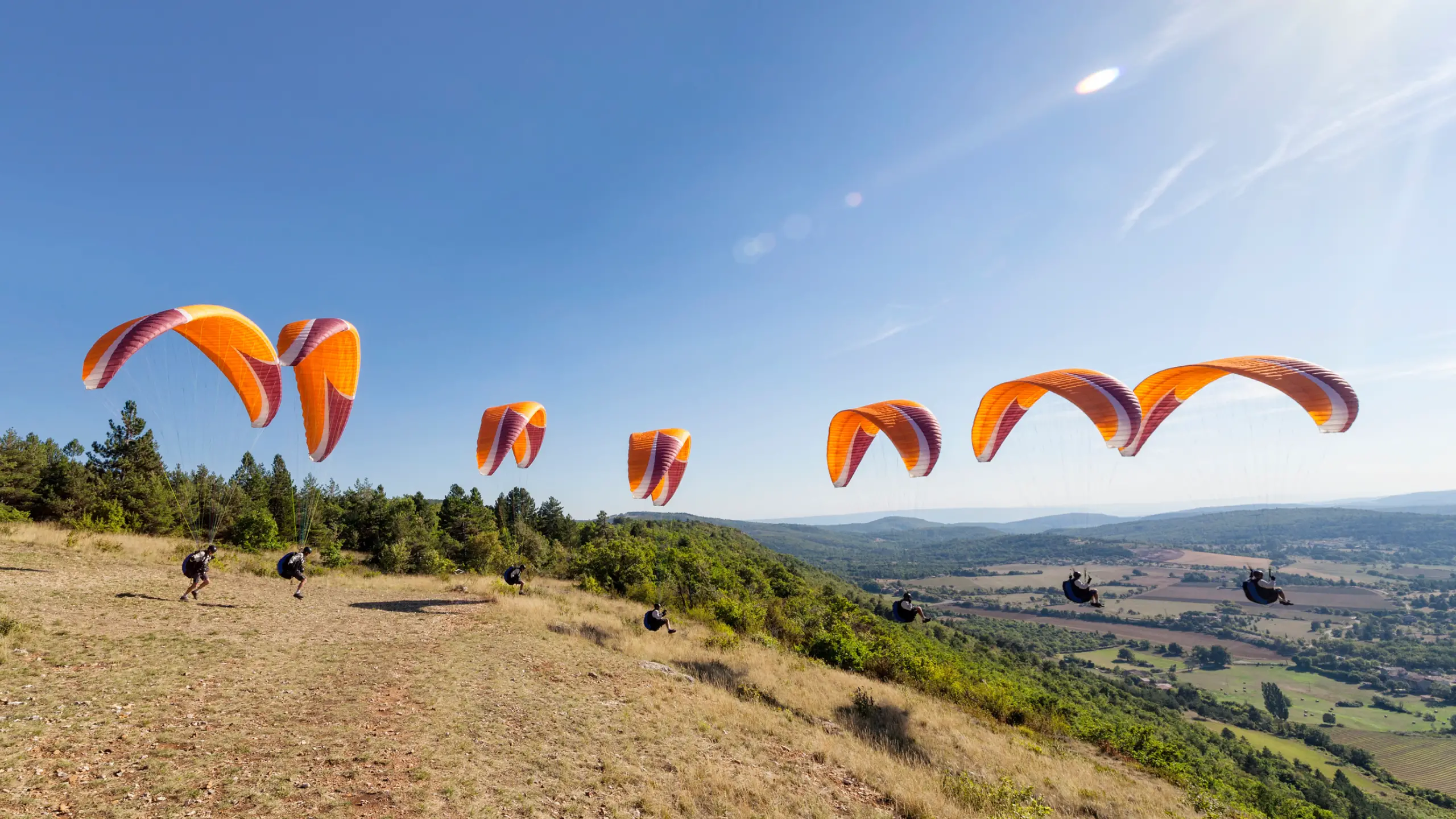How Do You Learn Paragliding?
Have you spotted paragliders flying high above a mountain and wondered how to learn paragliding? Or maybe you had a tandem paragliding flight and enjoyed it so much you simply need to know how to paraglide solo.
In this article, we’ll answer all of your questions about how to start paragliding.
What is paragliding like, is it for you?
Paragliding may seem like an extreme, adrenaline-fueled sport involving fearless athletes flinging themselves off mountain tops, but this isn’t the case. Although certain types of paragliding do fit this stereotype (like acro, for instance), most of the time paragliding is a serene, floaty experience.
Paragliding pilots are a diverse bunch from all walks of life, so if you find yourself dreaming of flight then give it a go.
Should I book a tandem flight before starting paragliding classes?
Flying tandem with an experienced paragliding pilot is an ideal way to get a taste for paragliding before investing in a costly paragliding course. This way, you’ll get to enjoy the view and the joy of flight, ask the tandem pilot any questions you may have, and experience just what paragliding is like without having to worry about controlling the paraglider yourself.
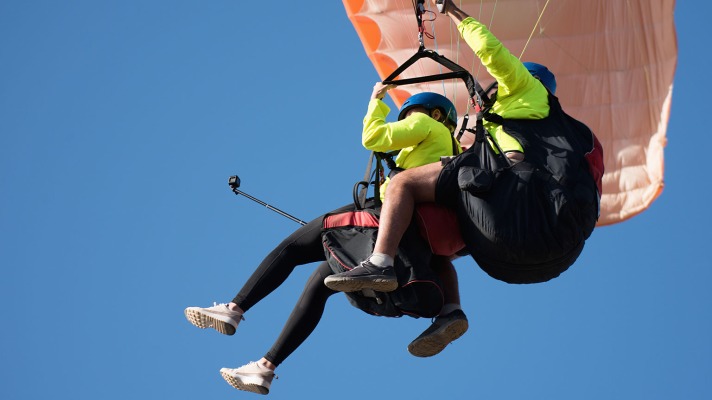
When booking your tandem paraglide, be sure you’re booking through a reputable company and that the tandem pilots are properly qualified.
If you’ve flown tandem but still aren’t sure you’re ready to commit to a full paragliding course, many paragliding schools offer taster days where you get hands-on experience in controlling the paraglider and in learning what paragliding is really like.
Can I learn to paraglide if I’m not an athlete?
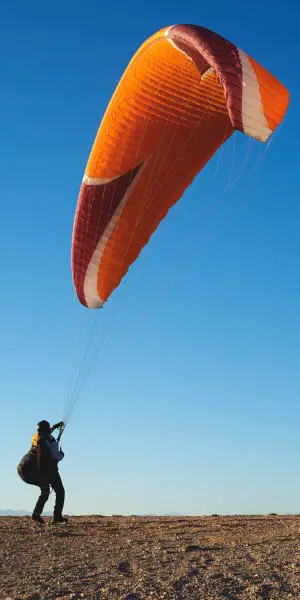
You don’t need to be particularly athletic or strong to learn to paraglide: as long as you are fit enough to manage to carry your paragliding rucksack up a hill (approximately 25 to 45 lb, depending on your kit) and agile enough to be able to kite the paraglider on the ground, then you’re as athletic as you need to be for learning paragliding.
The thought of trying to control such a large wing-flapping about in the wind may seem daunting, but brute force rarely comes into play with paragliding – it is more about finesse and understanding how the paraglider works. When you learn how to paraglide, you learn to use your body weight and the characteristics of the paraglider to keep it under control.
Can I go paragliding with a disability? Everyone should be able to experience the joy of flight, regardless of their physical abilities. There are several initiatives set up to help people with disabilities experience paragliding or learn how to paraglide. Check out Project Airtime in the United States, or the Flyability initiative in the United Kingdom.
Should I learn paragliding if I’m afraid of heights?
It will come as no surprise that those with a head for heights have a natural advantage when it comes to learning paragliding. But it is normal to have some fear of heights, so if you’ve always dreamed of flying then don’t let this put you off paragliding without at least first trying a tandem flight.
In fact, you’d be surprised how many people start paragliding classes simply to face their fear of heights.
However, if your acrophobia is severe, or you tend to suffer from debilitating vertigo, then you should proceed with caution, after a discussion with your doctor. If your doctor gives you the go-ahead to learn to paraglide, then inform your tandem pilot/instructor about any concerns and progress slowly through your paragliding classes to ensure you don’t put yourself in a situation where you may panic.
You do not need to be fearless to start paragliding. A healthy amount of fear keeps you safe and prevents you from pushing yourself too far too soon.
How to learn paragliding
OK, you’ve had a tandem flight and you’re obsessed – your Google search history is full of terms like ‘paragliding: how to learn’ and ‘where to learn paragliding near me,’ and YouTube is exclusively recommending videos of paragliding in exotic locations. Safe to say, you’ve caught the paragliding bug.
Your research may have led you to discover a wealth of knowledge and how-to guides about paragliding, but do not be tempted to learn paragliding on your own without a qualified instructor.
A qualified paragliding instructor will teach you the essential paragliding skills you need to know, guide your learning at your own pace, and sign off your rating at the end of training once you have demonstrated you can fly a paraglider safely.
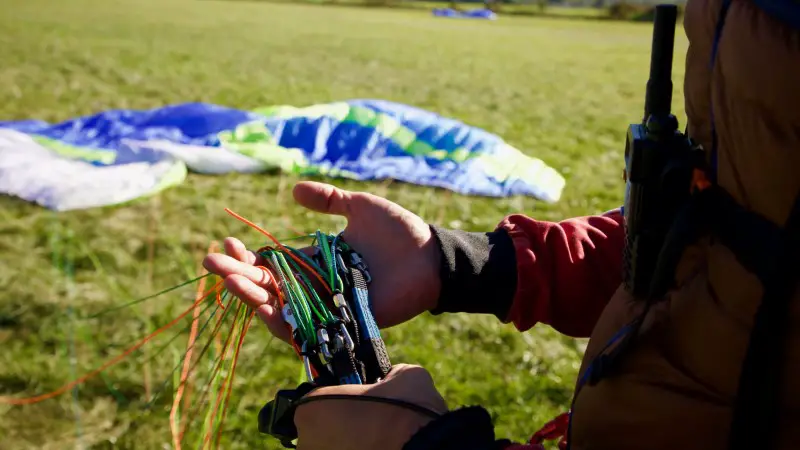
Why do I need a formal paragliding rating? You may hear about pilots buying paragliding equipment and ‘teaching themselves’ paragliding haphazardly to save some money, but this is not a good idea. When you learn to paraglide through the correct channels you obtain a rating recognized by the paragliding association in your country.
In the United States and the United Kingdom, for instance, your rating and affiliation with the United States Hang Gliding and Paragliding Association (USHPA) and British Hang Gliding and Paragliding Association (BHPA), respectively, also provide you with third-party insurance which will protect you should you accidentally damage someone’s property during an unplanned emergency landing.
Learning paragliding: How to get started
Your first port of call should be to find the website for your country’s paragliding association (e.g.,USHPA in the United States, BHPA in the United Kingdom). This is where you’ll find the local minimum requirements for paragliding unaccompanied in your country, a list of reputable paragliding schools affiliated with that association, and a breakdown of paragliding chapters/clubs in your area.
This information will give you a good starting point for deciding which paragliding school will suit you best.
Local requirements may differ, but paragliding qualifications are generally divided into two parts:
- The beginner pilot rating (known as P-1 in the United States, Elementary Pilot in the United Kingdom). In this phase, you learn the basics of how to control a paraglider but are not ready to fly independently without the guidance of an instructor.
- The novice pilot rating (known as P-2 in the United States, Club Pilot in the United Kingdom). In this phase, you become more proficient as an independent pilot, learn more advanced maneuvers, and have to pass an exam.
Where to learn paragliding: Local school near me versus a holiday package overseas
While researching the different paragliding classes available, you’re likely to come across enticing adverts for paragliding courses that are overseas or otherwise not local to you. Often these schools are set up in areas ideal for learning to paraglide: places with excellent weather, beginner-friendly takeoffs and landings, and stunning scenery.
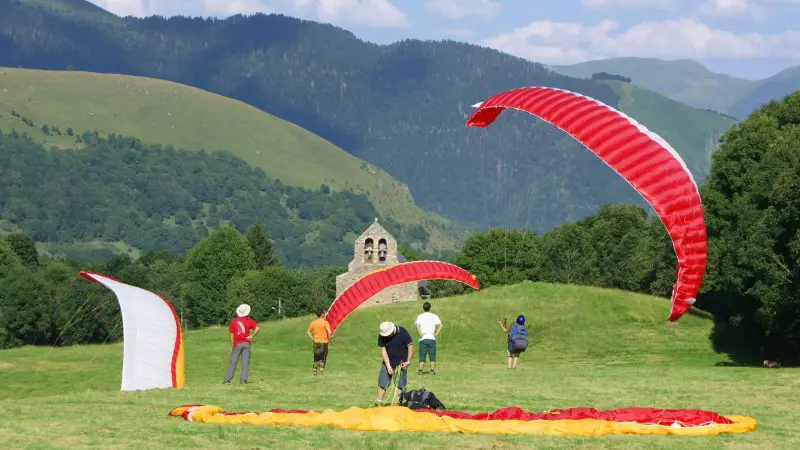
Paragliding schools set up in such a flying mecca will generally offer a package deal that includes a 1- or 2-week-long intensive paragliding course, along with the use of the school’s equipment, and possibly also accommodation and airport transfers. These courses are taught in small groups (often of around 6–8 people) and your instructor will take you from being a complete beginner to signing off your tasks for your rating (weather and pilot skill permitting, of course) by course completion.
If you live in an area known for bad weather, the closest reputable school is several hours drive from you, or there are no flyable hills or tow-launch fields near you, such a holiday paragliding package abroad may be an ideal option.
However, there are a few downsides to this option that you should be aware of before booking those flights:
- Ratings obtained overseas may not be equivalent to your country’s local requirements.
Different countries have different rating systems so it is important to be aware that just because you can demonstrate the proficiency required to paraglide solo in one country doesn’t mean you will be able to fly independently in another country. If you obtain your rating overseas, be sure to apply for an IPPI card, issued by the World Air Sports Federation (Fédération Aéronautique Internationale). The IPPI Card provides an internationally recognized system for comparing different paragliding ratings. - Lack of experience flying your local sites and reading your local weather patterns.
Although a lot of the information you’ll learn in your course will be applicable everywhere, you should not underestimate the importance of gaining insight from experts who fly in your local area. All paragliding sites have unique characteristics and quirks you’ll need to be aware of, so you’ll need to gain some additional local knowledge after you’ve qualified. - Lack of a local paragliding network.
No doubt you’ll make lifelong friends on your paragliding holiday, but after the course, you’ll head back home and find that you don’t know any local pilots. One of the best things about learning paragliding near where you live is that you will get to know other local pilots at the same level as you. It is a lot less daunting turning up at the hill as a newly qualified pilot when you’ve got your friends with you. This shouldn’t put you off wanting to learn overseas because you will make friends at your local paragliding club/chapter in no time, it will just take a little more effort. - Information overload – learning too much in a short time frame.
A paragliding holiday package can feel a bit like boot camp: you learn a whole lot in a short time. So, there may not be a lot of time for consolidation of knowledge and skills before moving on to the next new topic. If you’re a relatively fast learner and take to paragliding quickly, this shouldn’t be a problem. Your instructor would never push you beyond your abilities, but they may not be able to sign off all of your tasks by the end of the course if you aren’t ready. - Don’t believe the hype – good weather is never guaranteed.
This one speaks for itself, you may get unlucky with the weather no matter how reliable the conditions usually are.
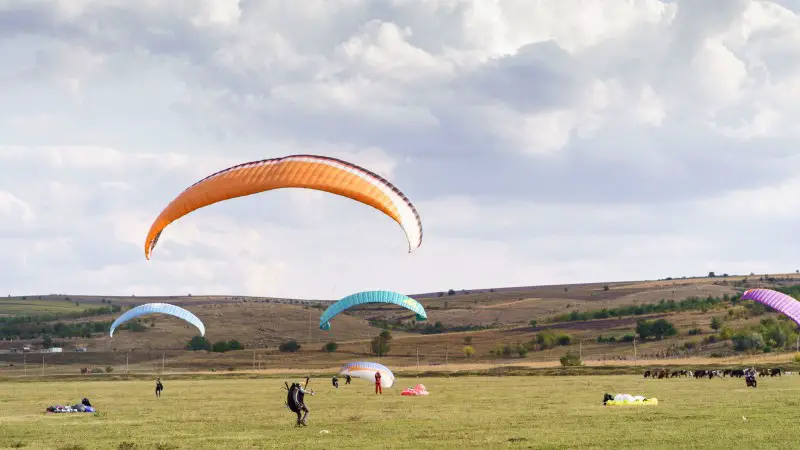
Does this mean that it is always better to learn paragliding near me?
This is an individual choice that comes down to your paragliding goals, where you live, and how you learn. If you live in an area with very few paragliding opportunities and you think you’ll do most of your flying overseas, then learning locally wouldn’t be worth it. If your local area has a great paragliding school but awful weather, you may progress through your course so slowly (over many weeks or months) that you forget your paragliding knowledge between sessions, or find it so frustrating that you quit before qualifying.
Your paragliding course
Right, so you’ve found a school and booked a course. What can you expect from learning paragliding and what equipment do you need?
What you’ll learn during your paragliding course
The fun begins! Attending your very first paragliding lesson may be intimidating, but don’t worry, you won’t be jumping off mountaintops just yet.
Paragliding instructors will follow their own course curriculum depending on local requirements, but the following is a good idea of what you can expect:
- Theory. Throughout your paragliding course, you will attend lessons on the theoretical side of paragliding, such as how and why the paraglider flies, meteorology, and air law.
- Getting to know the paragliding kit. First off, you’ll become accustomed to your paragliding equipment and all of the terminology involved, learn how to do your daily inspection, and learn how to pack your kit.
- Ground handling. Before you can even think about flying a paraglider in the sky, you need to learn how to control one on the ground. Ground handling will make up a large chunk of your initial paragliding lessons. Learning to kite your paraglider feels foreign at first, with a steep learning curve, but once you get the hang of it you’ll find it’s loads of fun, and you’ll gain so much confidence during this process.
- Small hops. Finally, your boots get to leave the ground. Once you can inflate your paraglider, kite it, and deflate it again safely on flat ground, your instructor will take you to a small, shallow slope and guide you through your first flights. These flights will be short and sweet, but they are an exciting point in your paragliding career.
- First big flight. Once you have mastered taking off (usually by a forward launch), flying in a straight line, making gentle turns, and landing safely, you’ll be ready for your very first big flight. Again, the instructor will be on hand during take-off, in constant contact with you over radio should you need their help, and there will be another instructor or assistant guiding you into the landing field. This will be your first true solo flight, and you will remember it for the rest of your life! This stage usually marks the end of the first phase of your paragliding course.
- Reverse launching, soaring, and other maneuvers. Next, you’ll learn how to do a reverse launch, how to soar, how to use big ears, how to use your speed bar, and how to react should your paraglider have an asymmetric tuck. To get your rating, you will need to demonstrate these skills to your instructor, who will sign the tasks off in your logbook.
- Written exam. Apart from demonstrating proficiency with the paraglider, you also have to pass an exam covering air law, meteorology, and the theory of flight. Don’t worry about this exam too much, your instructor will ensure you understand all of the theories.

Keen to do some background reading? To help you better understand the weather and theory of flight, many books would help broaden your knowledge: e.g., Touching Cloudbase by Ian Currer and Understanding the Sky by Dennis Pagen. If you’re in the United States, check out Paragliding: A Pilot’s Training Manual by Mike Meier and Mark Stucky; in the United Kingdom, see the BHPA’s Pilot Handbook by Mark Dale.
What do you need for your paragliding classes?
Most reputable paragliding schools will provide all of the paragliding equipment you need for your course, so you don’t need to buy a paraglider, harness, or other specialized equipment beforehand. After you finish the course, your instructor will advise you on what kit would suit you best.
Your paragliding instructor will let you know any specific items you should bring along with you to your first paragliding classes, but the following list is a good starting point:
- Good hiking boots with ankle support. The ankle support and cushioning of decent boots will protect your feet and ankles during hard landings and while learning to control your paraglider. Try to avoid boots with open lace hooks, if possible, because these can snag on the paraglider lines.
- Hydration pack/CamelBak. Proper hydration is essential for long days on the hill. Hydration packs are preferable over solid water bottles, which can cause injury if they are packed awkwardly in your rucksack and you are unlucky enough to fall on your back or get dragged.
- Layers, including long-sleeved shirts and long trousers. Be sure to keep your arms and legs covered during training, not only will this protect you from the sun and wind chill, but it will also protect your skin from bruises and grazes if you get dragged.
- Sunblock.
Next steps
One of the wonderful things about paragliding is that you’re always learning. After you’ve completed your basic qualification, you will be able to practice flying independently and progress onto more advanced paragliding courses, such as courses on thermalling, SIVs (which stands for Simulation d’Incident en Vol, or simulated incident in flight), and so much more.

